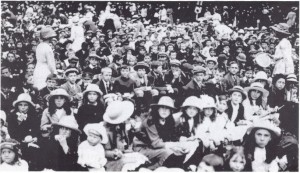
Henry Mylne, Wokingham’s Mayor throughout the war was to die just a few months after these peace celebrations of 1919.
The Great War. In which battles did the local servicemen fight?
The first year of our research was spent discovering the men who were killed in the War of 1914-1918 and we were surprised to find that our local fallen covered most of the major milestones of The War. There were those who were professional soldiers (‘The Old Contemptibles’) fighting a rear-guard action at Mons at the beginning of The War and also charging the last lance on lance battle in the September of 1914. One, a sailor, was sunk on the HMS Hampshire, alongside Lord Kitchener, the face of the ‘Your Country Needs You’ posters.
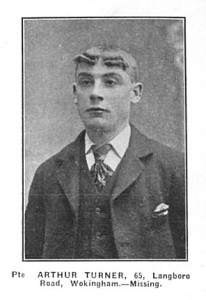
August 1914. Arthur Turner, killed during the ‘Retreat from Mons’ and the first Wokingham man of the Great War to be killed.
They were there at Ypres, Loos, Gallipoli, Mesopotamia, Jutland and the highest number were taken at the Somme. Their individual stories (A-Z) can be found on the black band running below the picture at the top of this page. There are also many photographs and films of the men, their lives, deaths and interactive family trees.
The war affected the whole community
When you find so many men killed in so small a community (Wokingham had a population below 4,000) it is possible to see how ‘clustered’ their lives were in certain parts of the town. There is a map at the bottom of the page which shows just how closely these families were entwined. Wescott Road and Havelock Road had particularly severe experiences; the houses still exist today and it is possible to visualise, although not fully understand the terrors this community experienced during The Great War. We have investigated over 400 family trees in the local area and inevitably they twist and intertwine together and it was not long before we realised these connections meant that notice of a death hit harder than just the immediate friends and family. Community had a different nature during these times; it was necessary and ‘hardwired’ rather than optional as it is today. Imagine a spiders web; one strand is touched and the whole web comes alive.
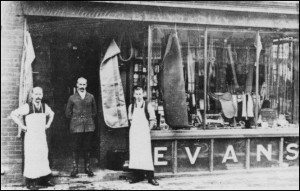
Peach Street, Wokingham. Charles Rideout is the young man wearing the apron on the right hand side, circa 1912. He was killed during the Battle of Loos, 1915.
We discovered with the help of our friends, that Wokingham was and is Britain’s ‘Everytown’. Like most towns, it has no famous neighbours, as Windsor or Eton have with their castle and school and did not grow out of the necessities of mining and industry; Wokingham has taken on many faces during its thousand year journey, quietly figuring out different ways to make a living and reinventing itself like the countless towns which pepper our nation. It is a silent history, unrecorded but every bit as important as any page from our history books.
If you examine the newspaper reports of everyday life the town during the war years (they’re on the side panel) there exists a strange dislocation; life carries on much as normal and at first there is the thought that the community took an ‘out of sight out of mind’ approach to the war.
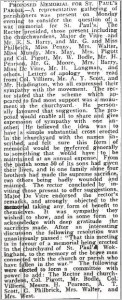
Click on image to increase size. This article presents the memorials as a form of thanks and sympathy, not as a mark of victory.
Imagine however, how the community would have been affected if the news told the real story of the war? Wokingham, as with other towns, took a ‘stiff upper lip’ approach. However, there are small pieces of information which tell us another story. Wokingham’s Mayor, HC Mylne died only a few months after the victory celebrations in 1919 and on more than one occasion his death was attributed to the exertions he experienced from his war time responsibilities. One of the examples we know of was his chairing of the committees which decided who were essential workers; ie who should stay at home and who should go to war. These were life and death decisions and Mayor Mylne would have known many of these men in person. The Mayor was not a hardened military leader of the General Haig mould, he was just a local man doing ‘his bit’ for the community. Imagine this man having to take such life and death decisions; they must have weighed very heavily upon him. No wonder he too is named on the Memorial.
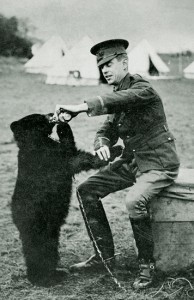
Harry Colebourn and and original Winnie the Pooh, before being seen by AA Milne and his son Christopher Robin at London Zoo.
The Great War and Modern Memory
Finally, again surprisingly, our childhood memories are entangled with the rich period of history. We all know Winnie the Pooh, War of the Worlds, the Jungle Book and some of us will recall that old German Shepherd dog Rin Tin Tin during our visits to Saturday Morning Pictures. As we come across these famous stalwarts of that period and their influence on our childhoods, they will be flagged up and presented either as stories or simple links to other sites.
All these ideas and more are presented on the right side panel of the Wokingham Remembers website. You’ll find some quite surprising stories.
Wokingham Today
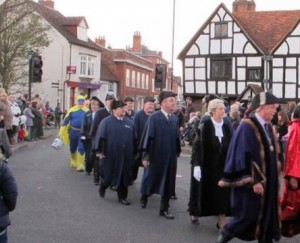
Today’s Wokingham is proud of its roots without taking itself too seriously. Hence the mix of super heroes and Council Members.
This great survivor of a town has now grown in population and sits at the top of the league of the nation’s most favoured places to live. Wokingham’s self-effacing nature though means it never really accepts this lofty position, instead choosing to continually argue and complain about itself, whilst at the same time bristling with pride of place. Wokingham Remembers therefore, continues to build the story of this Everytown; a place that used to be and a place that it has become. It is a very British story and one that is never found in the nation’s libraries – it is the real ‘Story of Us’. Of course to understand the ‘Story of Us’ as a nation, we need to know what was happening during this period on the national stage. Again, a quite staggering story emerges. 1900 to 1914 was not the tale of a genteel Edwardian Summer meandering toward the gates of hell as depicted in traditional histories of the war. The Edwardian period was chaotic, dynamic and in many ways replicates the challenges facing our own lives one hundred years later. By visiting this period we start to understand that the people of the time were not so different from us today.
A final word on the Town Hall Memorial.
Memorials were commissioned during the 1920’s as a way of expressing the grief felt by the individual friends and families of the Fallen. They were not organised by national or local government and payment for the memorials was privately funded. This means not all of Wokingham’s Fallen have been remembered in the memorials. It is an objective of this research to recall these men and ensure they do not disappear into the mists of time.
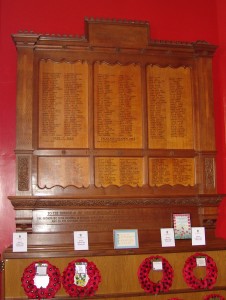 On the memorial board there are only names and therefore the possibility exists of mixing names; eg, ‘Richard Smith’ of Wokingham can be confused with a Richard Smith in say Reading. The Council deliberately removed any reference to status, as all are equal in death. This was a laudable decision, but as a result it has been really hard to trace the right man! Sadly, there are a number of Fallen, where no information exists. The cause is related to the understandable anarchy in constructing the memorial list. Some soldiers on the Memorial never lived in Wokingham and were remembered by family members who had moved into the area when the list was being constructed.
On the memorial board there are only names and therefore the possibility exists of mixing names; eg, ‘Richard Smith’ of Wokingham can be confused with a Richard Smith in say Reading. The Council deliberately removed any reference to status, as all are equal in death. This was a laudable decision, but as a result it has been really hard to trace the right man! Sadly, there are a number of Fallen, where no information exists. The cause is related to the understandable anarchy in constructing the memorial list. Some soldiers on the Memorial never lived in Wokingham and were remembered by family members who had moved into the area when the list was being constructed.
The conclusion we therefore reach, is that the memorial is not a list of those who died from Wokingham, but a symbol of a townspeople who wanted a permanent reminder of the loss they have suffered. Those loved ones are as much a part of the memorial as the men themselves and it is in this spirit of remembrance we hope you become inspired by the story of this small town, the place we call home.
